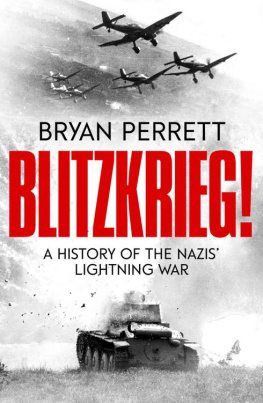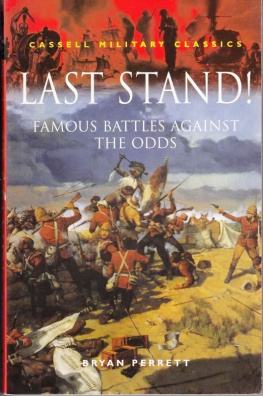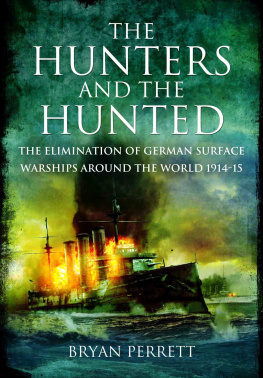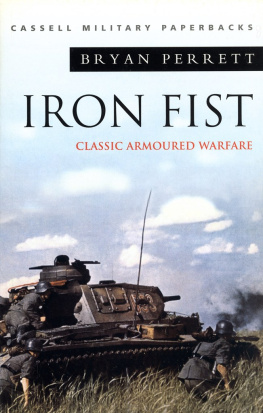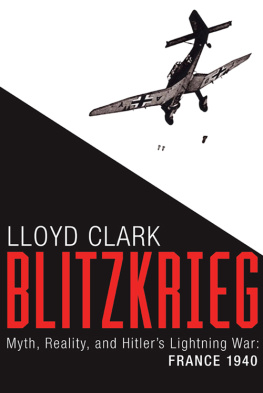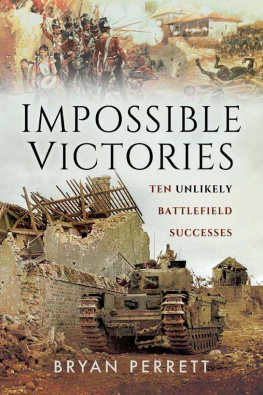Bryan Perrett - Blitzkrieg!: A History of the Nazis Lightning War
Here you can read online Bryan Perrett - Blitzkrieg!: A History of the Nazis Lightning War full text of the book (entire story) in english for free. Download pdf and epub, get meaning, cover and reviews about this ebook. year: 2022, publisher: Canelo, genre: History. Description of the work, (preface) as well as reviews are available. Best literature library LitArk.com created for fans of good reading and offers a wide selection of genres:
Romance novel
Science fiction
Adventure
Detective
Science
History
Home and family
Prose
Art
Politics
Computer
Non-fiction
Religion
Business
Children
Humor
Choose a favorite category and find really read worthwhile books. Enjoy immersion in the world of imagination, feel the emotions of the characters or learn something new for yourself, make an fascinating discovery.
- Book:Blitzkrieg!: A History of the Nazis Lightning War
- Author:
- Publisher:Canelo
- Genre:
- Year:2022
- Rating:4 / 5
- Favourites:Add to favourites
- Your mark:
- 80
- 1
- 2
- 3
- 4
- 5
Blitzkrieg!: A History of the Nazis Lightning War: summary, description and annotation
We offer to read an annotation, description, summary or preface (depends on what the author of the book "Blitzkrieg!: A History of the Nazis Lightning War" wrote himself). If you haven't found the necessary information about the book — write in the comments, we will try to find it.
Blitzkrieg!: A History of the Nazis Lightning War — read online for free the complete book (whole text) full work
Below is the text of the book, divided by pages. System saving the place of the last page read, allows you to conveniently read the book "Blitzkrieg!: A History of the Nazis Lightning War" online for free, without having to search again every time where you left off. Put a bookmark, and you can go to the page where you finished reading at any time.
Font size:
Interval:
Bookmark:
Blitzkrieg!

Sun Tzu, The Art of War , 500 B.C.
Foreword
by General Sir John Hackett
It is widely thought, in the impatient and often indolent Western culture of our time, that to find an acceptable name for something is to explain it. To tie a label on anything is too often held to be an adequate substitute for (or even identical with) its analysis. The use of the term Blitzkrieg lightning war offers a case in point. The word is universally employed to indicate a specific, highly effective mode of offensive action on the land battlefield. Precisely what that mode is remains somewhat obscure. Since the name given to it is far from precise this is scarcely surprising. The frequency of the terms application to what has happened in twentieth-century warfare suggests the importance of discovering what we are really talking about. The real purpose of the historical analysis presented in this book is to do precisely that.
Lightning strikes swiftly, in unexpected places and with enormous violence. Even when the probability of a lightning strike is known to be high, its target cannot be predicted with confidence and the blow, when it falls, comes with complete and often devastating surprise. But it is a single instantaneous event. Reflection on the nature of the operations to which the term Blitzkrieg is applied suggests that for that reason it is an inaccurate description of them. For although these operations may be conducted with speed, violence and initial surprise, it is not through instantaneous, but in sustained action that they succeed. The duration of the operation may be relatively short (though some of those to which the term is applied have been protracted) but it is in the unremitting maintenance of pressure during the whole of it that success lies. This is not at all the single, flashing, violent sword-stroke that the name implies.
The strategic essence of Blitz warfare is the indirect approach. Probably the most authoritative and comprehensive examination of the indirect approach in war is contained in Liddell Harts book under that title. He examines twelve wars, which decisively affected the course of European history from ancient times onwards, starting with what can probably be described as the first Great War in European history, that between the Greeks and Persians in the fifth century BC. He goes on to consider the eighteen major wars that followed, up to 1914 counting the Napoleonic Wars as one. In these thirty conflicts there were more than 280 campaigns. In only six of these campaigns, Liddell Hart points out did a decisive result follow a plan of direct strategic approach to the main army of the enemy. With the exception of Alexander, Liddell Hart claims, the most consistently successful commanders when faced by an enemy in a position that was strong naturally or materially, have hardly ever tackled it in a direct way. And when, under pressure of circumstances, they have risked a direct attack, the result has commonly been to blot their record with a failure. His enquiry leads him to two final conclusions. The first is that, in face of the overwhelming evidence of history, no general is justified in launching his troops to a direct attack upon an enemy firmly in position. The second, that instead of seeking to upset the enemys equilibrium by ones attack, it must be upset before a real attack is, or can be successfully launched. In Blitzkrieg , as we have come to know it, that is to say, in the application of the principles of the indirect approach through what have been found to be the most appropriate tactical methods, the destruction of the enemys equilibrium, both physically and psychologically, forms the essential basis of success. The attack itself, launched swiftly, violently, with maximum surprise and sustained with great speed and destructive force, is built upon it.
Tactically the Blitz method demands the swift exploitation of successes achieved in deep penetration between, or round, main centres of resistance, which are left for later reduction by follow-up forces. This is just the reverse of the practice to which so much of the appalling slaughter on the Western Front in World War I was due the committing in the attack of the strongest forces against the enemys strongest defensive positions. The basic principle of Blitzkrieg is to seek out for attack the points where the enemy is weakest and least expecting to be attacked; then, having broken in to secure a foothold, to pour in whatever can be found to develop, out of the break-in, a break-through. Liddell Hart, in analysing the theory after World War I, used to apply the descriptive term expanding torrent to indicate the nature of the follow-through.
There was not really anything odd or esoteric and certainly nothing new in all this. A brilliantly successful practitioner of the indirect approach in the Western Desert in World War II, General Dick OConnor, denied that he was applying any theory at all. What he did, he said, was dictated only by common sense.
The full development of the method in the land battle, however long its history, had to await the introduction of appropriate means, providing greater troop mobility, higher speeds and more effective mobile fire power. The wide application of the internal combustion engine in World War I, and the appearance in battle of the tank and the aeroplane, opened the door to Blitzkrieg as we have come to know it. The term may be imprecise, but it is now generally accepted and it is probably sensible to continue to use it.
The First World War already offered examples of the method, pregnant with warning of what could happen as weapons and equipment developed further. General Oskar von Hutiers action for the crossing of the River Dvina and the capture of Riga in September 1917 was a classic case. A more than usually competent Russian general, Klembovsky, commanding the 12th Army, expected to be attacked in his defence of the river line but was confident that the attack would fall first upon his own bridgehead, into which he had consequently put his best troops. Hutier, commanding the German 8th, played it the other way round, ignoring the bridgehead and crossing the Dvina elsewhere. He then by-passed the stronger positions and, having thrown the whole structure of the defence out of balance, swept on to the swift capture of Riga, the second port in Russia. In October of that year the same method was used by von Belows 14th Army in Italy to cause the complete collapse of the Italian 2nd Army at Caporetto on the Isonzo, driving the Italians back seventy miles to the River Piave. If Below had had cavalry, or better still armoured cars, the rout would probably have been such as to drive Italy out of the war.
The tank had already made its appearance. In November 1917 it was used on the Western Front to break the Hindenburg Line at Cambrai and open a way for British cavalry to drive through to the German rear. The follow-up was too slow and a great opportunity went unused. The German counter-offensive that followed was a stunning success: all ground that had been lost to the tanks was by 7 December recovered. Few people understood why. It was not widely appreciated, or even known, that the Germans had now added aircraft to the equation. The outline pattern of what we know as Blitzkrieg was complete.
The author points out, as a matter of interest, that in the Caporetto campaign two men who were in the Second World War to show a high mastery of the method were on opposite sides. They were OConnor and Rommel, both light infantrymen. This prompts me to reflect that the swiftness with which early tactical success is exploited and the flexibility of command structures that makes such exploitation possible are two keys to the successful application of the method. In Vienna in 1946, after a war in which I had experienced Rommels use of it at first hand, and after diligent search, I found a copy of Rommels own book Infanterie Greift an based on his experiences as a junior officer in the Infanterieregiment Konig Wilhelm I. (6. Wurttemberger) , in which he started the war as commander of No. 7 Coy. It should be remembered that the companies in a German infantry regiment were numbered consecutively all the way through, the battalion (a majors command) being more of an administrative than a tactical headquarters.
Next pageFont size:
Interval:
Bookmark:
Similar books «Blitzkrieg!: A History of the Nazis Lightning War»
Look at similar books to Blitzkrieg!: A History of the Nazis Lightning War. We have selected literature similar in name and meaning in the hope of providing readers with more options to find new, interesting, not yet read works.
Discussion, reviews of the book Blitzkrieg!: A History of the Nazis Lightning War and just readers' own opinions. Leave your comments, write what you think about the work, its meaning or the main characters. Specify what exactly you liked and what you didn't like, and why you think so.

